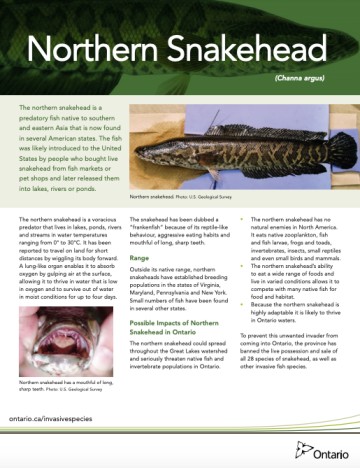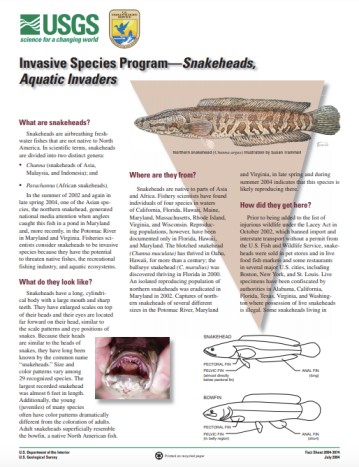Northern Snakehead (Channa argus)
French common name: Poisson-serpent du Nord
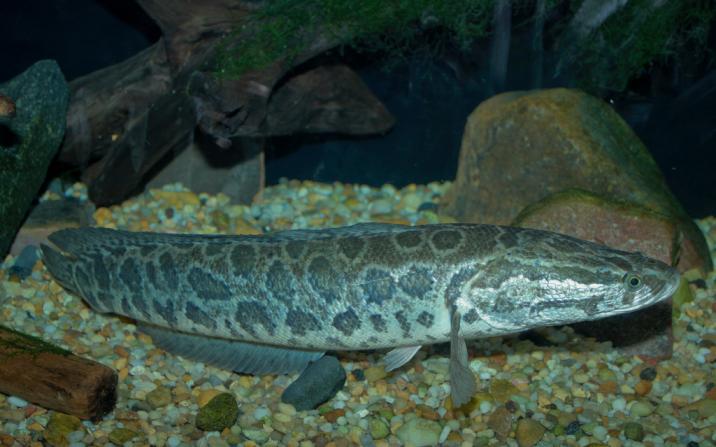
Northern snakeheads can reach up to 85 cm and have a dark and light brown mottled, thin elongated body.
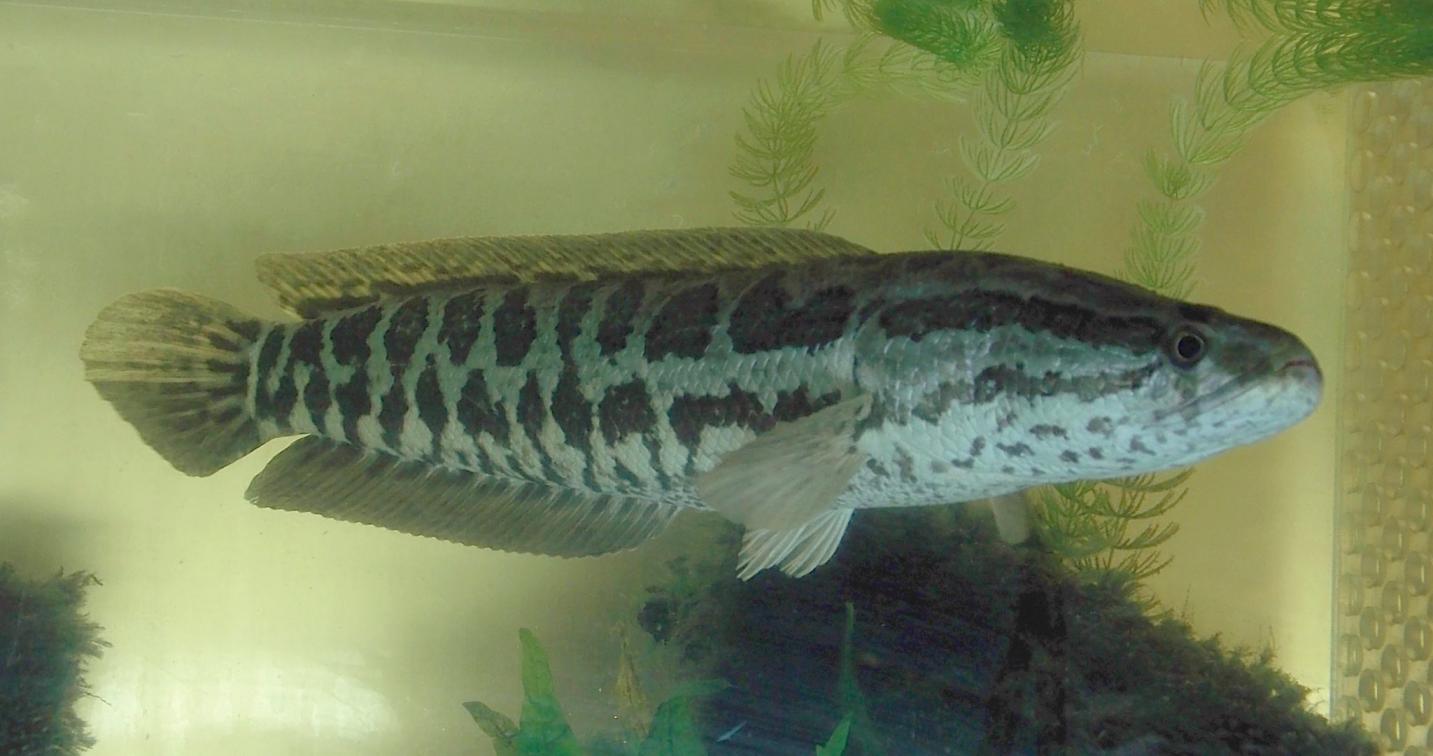
It is against the law to have a live snakehead in your possession.
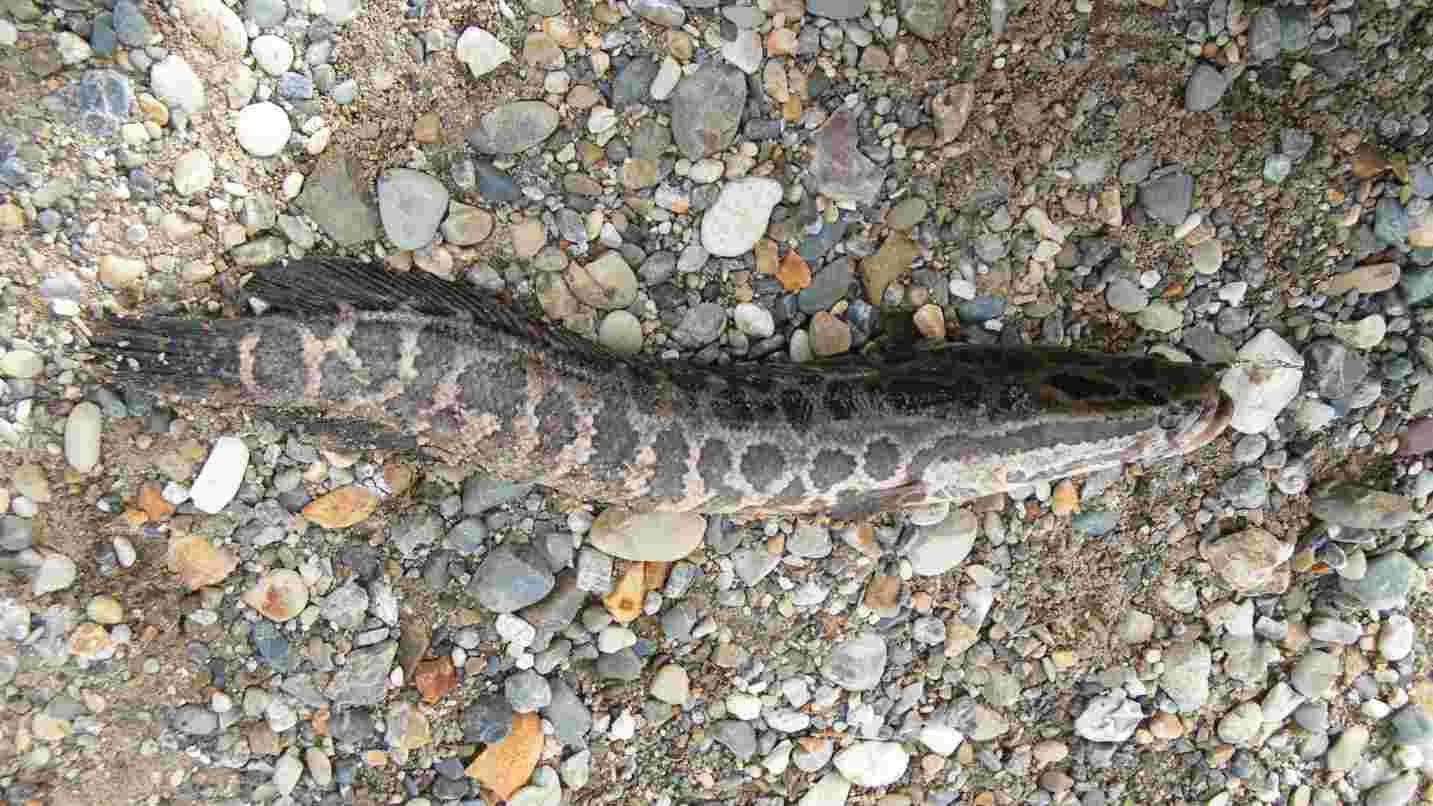
Snakeheads can “walk” short distances on land; a lung-like organ allows them to survive out of water for up to four days.
Order: Actinopterygii
Family: Channidae
The northern snakehead is a predatory fish that can live in a wide variety of water conditions. They have the ability to “walk” short distances on land and their lung-like organ allows them to survive out of water for up to four days. Northern snakeheads can reach up to 85 cm and have a dark and light brown mottled, thin elongated body. They have a large mouth filled with teeth and a single long dorsal fin. This fish can consume a wide variety of food including fish, amphibians, insects, invertebrates, small reptiles, birds, and mammals. Although not in the Great Lakes, the northern snakehead would be capable of adapting to these waters easily. It is against the law to have a live snakehead in your possession. Do not transport or release live fish into any waterbody.
Northern snakeheads are long, thin fish with a single dorsal fin running the length of the fish. The overall color is brown with dark blotches. It has a somewhat flattened head with its eyes located on the top (dorsal) side of its body. It has tubular nostrils and elongated dorsal and anal fins. (Courtenay and Williams 2004). Males are darker in color, and have a broader head, as compared to females (Gascho Landis and Lapointe 2010). Juveniles have a similar color and pattern as adults.
Size: Maximum size exceeds 85 cm (33 in).

The northern snakehead is a voracious predator that lives in lakes, ponds, rivers and streams in water temperatures ranging from 0-30°C. It has been reported to travel on land for short distances by wiggling its body forward (Ontario Fact Sheet).
Native range: China, Russia, and Korea (Courtenay and Williams 2004). The northern snakehead is found in the lower Amur River basin. It is native to all but the northeastern regions of Korea, as well as the rivers of China. (Courtenay and Williams 2004).
Invasive range: Outside its native range, northern snakeheads have established breeding populations in the states of Virginia, Maryland, Pennsylvania, and New York. Small numbers of fish have been found in several other states.
Specific impacts are unknown surrounding the Potomac (census designed place in Maryland) population. These predatory fish may compete with native species for food and habitat. Juveniles eat zooplankton, insect larvae, small crustaceans, and the fry of other fish. Adult snakeheads feed almost exclusively on other fishes (>97% of diet), with the remainder of their diet composed of crustaceans, frogs, small reptiles, and sometimes small birds and mammals (Courtenay and Williams 2004; Saylor et al 2012). Adult snakeheads show significant diet overlap with largemouth bass (Micropterus salmoides), with both consuming a large proportion of fundulids and other centrarchids in the lower Potomac River (Saylor et al. 2012).
Impacts
The northern snakehead could spread throughout Canada’s watershed and seriously threaten native fish and invertebrate populations.
- The northern snakehead has no natural enemies in North America. It eats native zooplankton, fish and fish larvae, frogs and toads, invertebrates, insects, small reptiles and even small birds and mammals.
- The northern snakehead’s ability to eat a wide range of foods and live in varied conditions allows it to compete with many native fish for food and habitat.
- Because the northern snakehead is highly adaptable it is likely to thrive in Canadian waters
Fact Sheets
Best Management Practices

Lorem ipsum dolor sit amet, consectetur adipiscing elit. Ut elit tellus, luctus nec ullamcorper mattis, pulvinar dapibus leo.
Articles
Comparative distribution and invasion risk of snakehead (Channidae) and Asian carp (Cyprinidae) species in North America
snakehead (Channa argus), blotched snakehead (Channa maculata), Chinese snakehead
(Channa asiatica), bullseye snakehead (Channa marulius), and chevron snakehead …
Diet of non‐native northern snakehead (Channa argus) compared to three co‐occurring predators in the lower Potomac River, USA
represent a substantial management concern to global biodiversity. One of the most recent
non‐native fishes to successfully establish in North America is the northern snakehead …
[BOOK] Risk assessment for northern snakehead (Channa argus) in Canada
temperate to tropical areas. The cold temperate snakehead, northern snakehead (Channa
argus), is found in areas in Russia, China, and Korea. Northern snakehead is highly …
Current Research and Knowledge Gaps
Lorem ipsum dolor sit amet, consectetur adipiscing elit. Ut elit tellus, luctus nec ullamcorper mattis, pulvinar dapibus leo.
Further Reading
The Invasive Species Centre aims to connect stakeholders. The following information below link to resources that have been created by external organizations.

